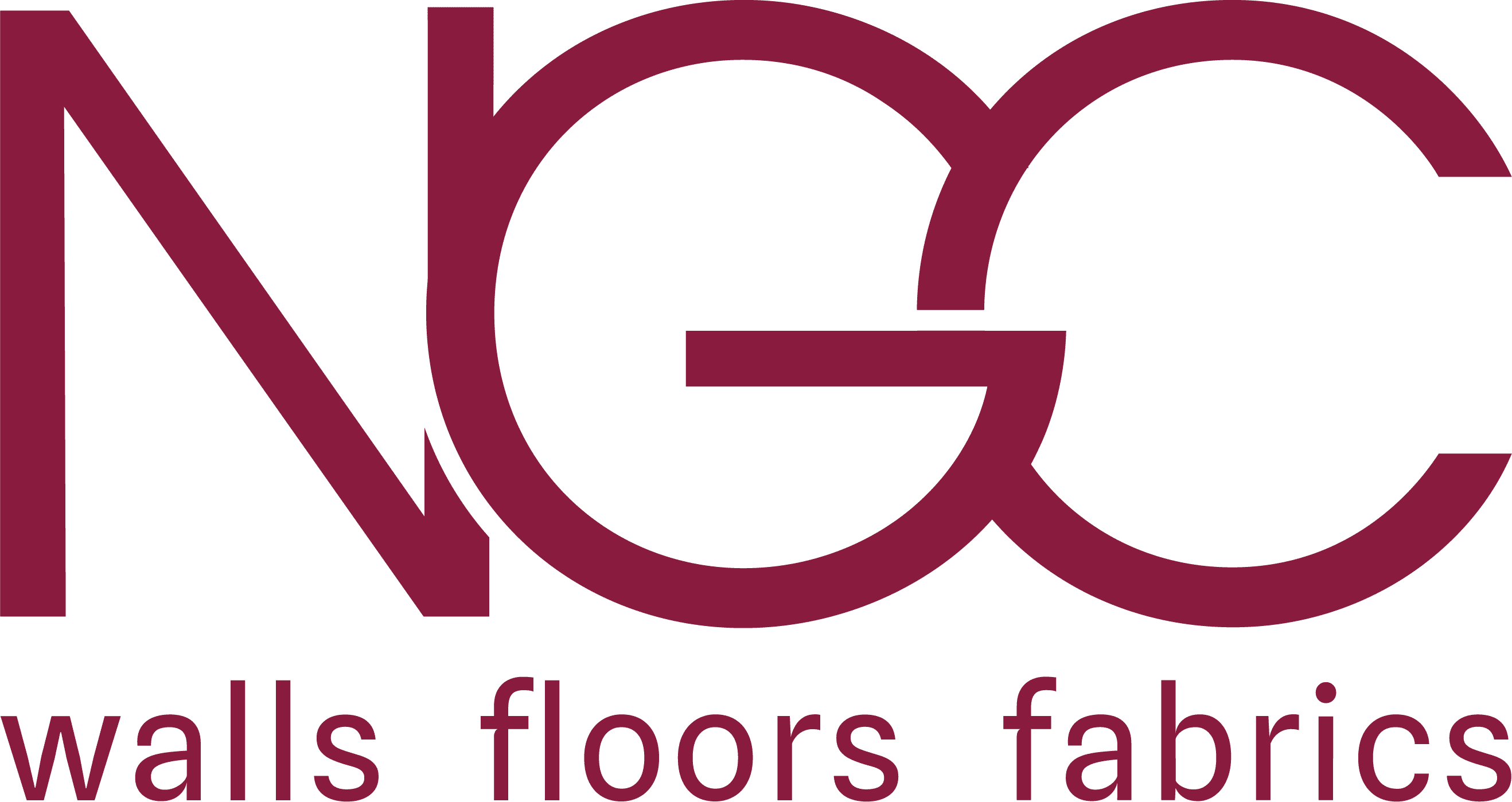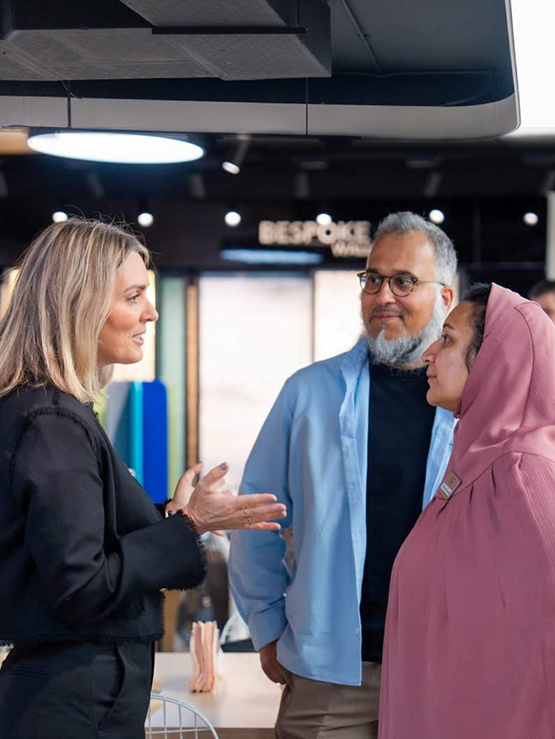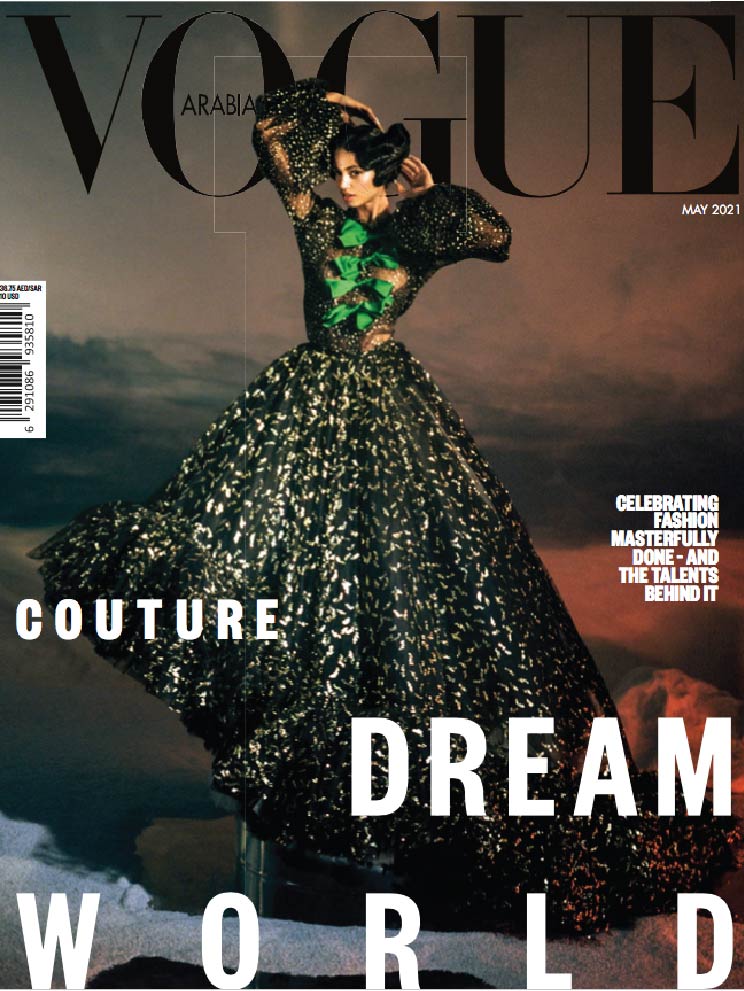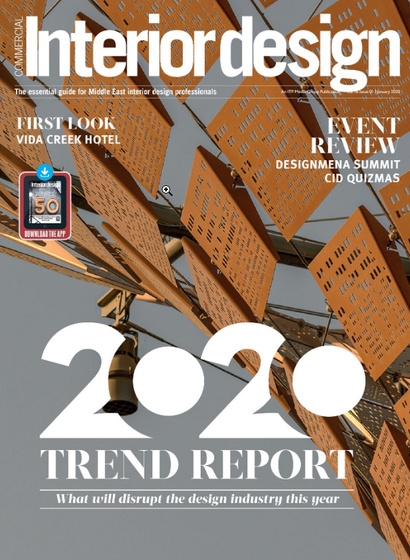Please complete the form.
Fields marked with an asterisk * are required.
In the third episode of FF&E Talks with NGC Nafees Season 2, the panel explored the evolution of biophilic design in the workplace, moving beyond the basic inclusion of plants and natural light to the innovative integration of smart technology and evidence-based design principles. The discussion featured a distinguished panel including Annabelle Cleary from INC Solution, Chris Barnes from Broadway Interiors, Rita Estephan from Motif Interiors, Dragana Cemalovic Ndedu from Bluehaus, Cris Doctor from Summertown Interiors, Mansi Tiwari from AAID, and Vishal Sachdeva from Spacewell Interiors. The panelists discussed how these environments can dynamically adjust to optimise employee well-being and productivity.
NGC recently launched Season Three of its FF&E Talks video series with a dynamic panel discussion on “Luxury Retail vs. Functionality: Striking the Right Balance.” The conversation brought together some of the region’s most innovative retail designers—Helen El Mettouri (Zebra Global), Marko Runjic (Point Concept), Omar Nakkash (Nakkash Design Studio), Shanon McGuffog (Edit Co.), Rima Antoun (Sanctuaire Exotique), and Malek Diouri (Store Makers) — to explore how luxury brands can craft immersive, future-proof spaces that prioritise both elegance and practicality.
Alafiyah Kagalwala is a creative force with a clear vision and dedication to the art of design. As the Creative Director at NGC, a family business she has helped shape and grow over the years, Alafiyah’s journey in the design world has been one of hard work, passion and an ever-deepening understanding of the power of space and creativity.
At Downtown Design 2024, the NGC stand sprouted a wing – literally! The stand was more than a showcase of products; it was an experiential journey conceptualised and designed by Brand Creative. Titled The Pond, this installation continued the story that began at last year’s fair. A Japanese underwater theme marked NGC’s debut participation at Downtown Design in 2023, coinciding Dubai Design Week’s decade-long presence in the industry.
After 40 years in the UAE’s interior design scene, NGC is stepping into a new era. Renowned for wall coverings, fabrics and flooring, NGC has now rebranded with the tagline “We help redefine spaces,” embracing growth, innovation, and a vision that looks beyond walls alone. This refreshed identity captures not only NGC’s legacy but also its future ambitions in design and fit-out solutions.
In the latest FF&E Talks video series, the panel explored how lobby spaces are evolving into dynamic multifunctional hubs. Distinguished panelists—Mena Ahmed from Gensler, Veda Setty from Bond Interiors, Susana Aldrabinha from DLR Group, Yose Suprayogi from Kristina Zanic Consultants, Francesca Patti from Bishop Design, Nikita Chelani from Roar, and Mira Kurniawan from DWP—shared their insights on creating engaging, revenue-generating, and sustainable lobby designs.
The latest FF&E Talks panel, “Blending Cultures: Global Influences & Storytelling Through F&B Design,” moderated by Marina Mrdjen, highlights how cultural storytelling and practical design elements are transforming F&B spaces. Insights from Dina Murali, Shereen Hassanein, Carina Lima, Kimberly Dean, and Marcus Maximus showcase the importance of merging creativity with practicality. The discussion delves into understanding the chef’s vision, balancing aesthetics and functionality, and the role of local craftsmanship in sustainable design. FF&E is shown to be pivotal in creating immersive and memorable dining experiences.
Broadway Interiors, partnering with several companies, created a sustainable stage design for the Workspace Summit 2023 in Dubai. The design emphasized eco-consciousness by using second-hand and recycled materials, fostering a collaborative and innovative environment. The project, which evolved over two years, featured a stage with green walls and warm lighting, and flexible seating arrangements. This initiative highlighted how sustainable design can enhance functionality and aesthetics, setting a benchmark for future projects.
In the third episode of FF&E Talks with NGC Nafees Season 2, the panel explored the evolution of biophilic design in the workplace, moving beyond the basic inclusion of plants and natural light to the innovative integration of smart technology and evidence-based design principles. The discussion featured a distinguished panel including Annabelle Cleary from INC Solution, Chris Barnes from Broadway Interiors, Rita Estephan from Motif Interiors, Dragana Cemalovic Ndedu from Bluehaus, Cris Doctor from Summertown Interiors, Mansi Tiwari from AAID, and Vishal Sachdeva from Spacewell Interiors. The panelists discussed how these environments can dynamically adjust to optimise employee well-being and productivity.
In the second episode of FF&E Talks with NGC Nafees Season 2, a distinguished panel of design experts discuss sustainability in FF&E Design within the hospitality sector. The panel included Lara El Hani, Head of the Interior Design Department at Kling Consult; Swati Rokade, Associate at Godwin Austen Johnson; Aleksandra Nastic, Senior Associate at Woods Bagot; Casey Carillo, Interior Designer at LW Design; Medhat Maher, Studio Director and Senior Associate at DiLeonardo; Monica Twarowski, Design Director at EMA Studio; and Leena Ibrahim, Design Director at ōpaal Interiors, and was moderated by Marina Mrdjen from Intelier.
In a world where luxury and innovation converge, the field of interior design is experiencing a remarkable transformation. NGC Nafees, a Dubai-based distributor of walls, floors, and fabrics, and Tapetex, a renowned Dutch high-end wallpaper manufacturer, in collaboration with Intelier and Identity magazine brought together a selected group of leading interior designers and thought leaders, specialising in the hospitality and residential sectors. We asked these experts to offer insights into the emerging trends in high-end interiors in 2024.
From bold colours, timeless aesthetics, and immersive experiences, within this exclusive report, we delve into their forecasts for luxury design, encompassing a shift towards bolder colours, personalisation, experimentation and a seamless fusion of technology and artistry.

“The most significant shift is that we’re moving away from exclusively creating safe designs, which predominantly focus on tonality and monochromatic interiors. So, no more reliance on just beige and gray tones. Now, we are encouraged to experiment more with colors and textures, introducing a layering effect in our interiors. This allows for specific elements, such as a cushion or a feature wall, to become a part of your DNA for the entire hotel design.
When discussing hospitality, and similarly for residential projects, clients are now seeking more bold colors, bold interiors, and experimental designs, moving away from the previously safe designs. This is the direction we’re heading in. Most hotels and operators aim to maintain their brand and the iconic look and feel of the brand.
However, with our creativity as designers, we can always enhance this experience and look by incorporating our own design languages and DNA.
Indeed, we will be moving away from minimalist, safe designs toward more intricate layering and additional details. We will see an increase in the use of metal inlays, diverse textures, and timber inlays in our ceiling and wall designs.”
“I believe we are transitioning towards a concept of quiet luxury, characterised by timeless interiors. We’re likely to witness an increase in silver accents, moving away from goldish surfaces. Decorative surfaces will remain prevalent, perhaps with a focus on sculptural furniture pieces, and we will definitely see vintage elements being incorporated into interiors. Imagine integrating vintage lighting from the Italian and French eras of the 1950s into a beautiful, timeless space, possibly featuring marble surfaces and marble furniture pieces, adding a sculptural element to the interiors.
So, it seems we are still favoring warmth, natural hues, and materials and these elements are expected to be prominent in the forecast for luxury interiors.”
“I would say hospitality is definitely going to focus heavily on experience. Therefore, all materials that contribute to this experience, whether through touch and feel, play a significant role. Trendy colors may come and go, but I believe the involvement of local artists and heritage can provide a unique identity to a place, based on its location and context. This approach could significantly enhance the experience for people. Involving local artists and materials, which also ties into sustainability especially after COP 28, will be crucial.
Other trends will obviously include AI, incorporating everything from social media to creating ‘Instagrammable’ moments. This isn’t new, but anything that contributes to this, be it materials, sculptures, or installations, will remain relevant for some time. AI’s role extends beyond operational aspects in hotels to utilizing data for personalized experiences and solving robust problems.
The driving force behind hospitality will be the overall experience, whether it’s geared towards health, visual appeal, or emotional well-being. This, I believe, will be the main driver.”

“I’d like to see a much more eclectic design approach, one that is bold and dynamic. I believe that’s the direction in which design is heading. People are becoming more daring, so I’m hopeful that we will start to move away from overly calm interiors.
For me, luxury is fundamentally about space, not necessarily the colors or materials used. It’s about how we utilise that space. That’s what luxury means to me.”
“I think the last two years have seen a lot of the quiet luxury kind of experience, with soft tones, tone-on-tone, the neutrals, and the beiges. We’ve definitely worked on a lot of them ourselves. But I do think that 2024 will be a celebration of richer tones in terms of colors and textures. I think people are going to be a bit more bold and dynamic with layering. Certainly, we love to do that in our own studio, with color and different textures, working with fabrics and wall coverings to create a layered effect.
And I do think some of the best designers know how to layer, with lots of different elements. It’s just like developing a story. We all talk about narrative and building a narrative. It’s the same with space. There’s always a canvas of some sort, but from there, you build on it.
And I believe the richer tones, especially when it comes to accessories and art, will see a unique approach. Instead of calling it a trend, a more authentic approach to art and accessories will be taken, where things will be much more personalized and may touch on history and things like that.”
“As a design studio specialising in luxury design and lifestyle projects, we are deeply interested in storytelling or crafting narratives through our work.
For luxury design, it’s primarily about the experience itself. I believe guests now seek to immerse themselves fully in that experience. The more impressive the experience, the better guests feel about the design, particularly when discussing luxury.
It also encompasses comfort, the overall ambience, and the sense of relaxation, which can vary from one guest to another based on their background or what they are seeking. Regarding colours, neutral and muted tones have been prevalent in previous years.
However, I feel that natural colours are still present but now in a bolder form, such as earth tones with more vibrancy, like terracotta and deep green, mixed with some muted metals. This represents the evolving luxury trend in colour schemes.”
“So, I feel like we’re at a point where what is termed ‘quiet luxury’ prevails, yet we’re incorporating a lot of technology into our projects in a manner that allows us to blend the culture of the space seamlessly, achieving a very understated tone, not overtly bold with the colours we use. However, we do employ accent colours, predominantly in hospitality, which is very much about creating tranquil spaces. These spaces merge with the local culture, allowing us to insert numerous small details and utilise what technology offers us today, thereby reinventing our approach to design daily.
For this year, regarding pops of colour, we’re likely to see shades of jewel yellows and even the new Pantone colour, which leans towards salmon, introducing warm colours into a neutral palette.”
“I think a lot of what’s happening in this community, in the design world at the moment, is we’re seeing a lot of collaborations. And I think what’s shifted is that we’ve seen luxury, obviously luxury products, luxury brands in the industry, in the market for a long time.
And now we’re seeing them wanting to create their own environments and really bring their touch of luxury into a lifestyle, into an environment. So, we see more collaborations, and I think even today is a great example of collaborations and the people that are involved today. And that’s what is driving, I guess, a lot of the projects that we’re certainly involved with and even independently. We are now seeing branded residences in isolation, without the hotel attachments to these spaces.
So that’s what I think is probably the biggest trend that we’ve seen in terms of the diversity of projects and the projects that we have on board.”
I can see an emergence of traditionalism, coupled with a fearlessness in using color. Moreover, luxury spaces are no longer just designed but also decorated. There’s a re-emergence of antique pieces in very contemporary spaces and great detailing, such as gypsum on the ceiling. However, it still incorporates contemporary features, indicating a mix of design trends, which is emerging and pleasant to observe. I see a lot of jewel colors coming through; I’ve been dabbling in a lot of amber and ruby. Another trend I find really interesting for 2024 is the predominant mixing of metals. Here, and in the gorgeous Atlantis piece we added, there’s a blend of stainless steel, chrome, and a mix of bronze, brass, and copper. I would really welcome moving away from everything being tone-on-tone and matchy-matchy, if you will.
I feel luxury has always been present, but now there’s a significant emergence of expressing oneself and letting personality shine through in spaces. Personal touches to any space are now embraced without hesitation.”
“I’d say there’s obviously a push for sustainability, but I think what’s important is the honesty in sustainability, not just using it as a slogan, but actually executing on it. This includes where the materials are coming from and how they are being produced. Taking it a step further involves maintaining the purity of craftsmanship within those materials and reverting to basics for the longevity of materials.
Because quite often, I’m not necessarily fond of the word “trend” because it implies something temporary that will come and go. But I think adopting a holistic approach is what’s needed, aiming for what could be called the ‘slogan of the day.’ I found ‘classic craftsmanship’ quite fitting. It embodies the honesty of the material and the work, including when it’s produced locally.
I think there’s more layering now. You have the simplicity of materials, and this simplicity is what gives them longevity because it’s timeless. However, layering them with textiles or wall coverings offers a classical look as well, but brought in a modern way that’s refined and not over-cluttered, yet refreshing.”
“In 2024, things appear quite peaceful. The trends and colors emerging in both hospitality and residential sectors are soft, more natural, and textured.
I observe a significant demand for colors like sage and stone—soft hues, but interior design often tends to follow fashion to some extent. Thus, there are always strong pops of red or other elements trending in fashion that gradually seep into interiors and hospitality. That seems to be the current trend.
Luxury, to me, is conveyed through feeling. It’s always about how you feel in a space. A simple place can exude luxury, and that’s down to the colors and textures introduced into that environment. It’s not really about the bling. It’s about how one feels in the space. That’s what luxury represents to me.”
“People are becoming more perceptive about luxury. They visit places and return with newfound knowledge. However, a new trend is emerging where more natural finishes are making a comeback. We’re seeing an increase in textures, subtle colors, and even a bit of ethnic or beachy colors, such as sandy tones. Warm tones are returning, contrasting with some vivid colors typically not associated with luxury.
Luxury embodies timelessness and elegance, along with value in the finishes. There’s a resurgence of colors. The color of the year has been trendy since last year, so its continued popularity isn’t surprising. Nowadays, it’s not just about the main color of the year but the entire palette that accompanies it. These tones provide contrast and complement each other, contributing to the overall atmosphere, infused with feelings and emotions.”
“I believe that this year we’re truly craving for personality, an original vintage look that weaves the past and future together.
I’m not keen on using the word ‘trends,’ but it’s evident that design is gravitating towards craving for personality, embracing uniqueness, and not shying away from mixing colors and patterns. In terms of the color palette, we’re advancing towards a preference for chocolate tones, rich browns, high-end use of walnut, and the profound depths of dark woods. Regarding color trends, which I’m not fond of, it’s clear we’re revisiting that French look and feel, reminiscent of vintage aesthetics.
Overall, I believe 2024 will be about discovering your own personality, not just discussing styles, but truly creating a harmonious composition.”
“My color for 2024 will be green in all shades. I believe we will see an increase in colors, patterns, and textures, definitely. It seems we are transitioning from the beige era to something a bit more playful and engaging.
I wouldn’t label it as maximalism, but rather a gradual shift in that direction, which undoubtedly makes our work much more enjoyable.
For me, luxury embodies timeless comfort. It’s about creating an environment that feels like home, particularly since I focus on residential projects, yet also places you in a distinctive and intriguing space.
It’s a comprehensive experience of colors, textures, and uniqueness. This is what luxury represents to me.”

“For 2024, in luxury interiors, I anticipate a significant trend towards more natural materials. This includes a shift towards earthy tones and raw textures. Personally, I’m observing a slight decline in the popularity of large slabs of tile and porcelain tile.
I’m increasingly drawn to the authenticity of real marble and stone, appreciating their depth and texture. This preference extends to wall coverings as well.
In 2023 and 2022, we witnessed a dominance of whites, off-whites, and very light tones.
For 2024, I foresee colors becoming stronger and darker while maintaining a very natural feel. My personal favorite color for 2024 is akin to burnt caramel. It leans towards brown but incorporates a hint of slightly rusty orange. This color is incredibly warm, cozy, and adds an elevated touch to any space.”
“So, what’s really capturing the luxury interiors currently are the rich, dark tones such as charcoals, blacks, along with deep, moody emerald purples and navy. These colors are defining the aesthetic of this year, offering a deeply intimate vibe that invites individuals to immerse themselves in a space that feels both personal and expansive. This palette allows for sophisticated interplays of lighting and textures, creating environments that are enveloping, dark, and incredibly moody.
Moreover, a significant trend I’m observing is the integration of digital art into interior spaces. This movement towards incorporating digital art, along with innovative lighting effects, is setting a modern and urban tone. It’s not just about the aesthetic appeal but also about creating dynamic spaces that reflect contemporary life, blending art and technology in ways that are cutting-edge, trendy, and uniquely expressive.”
“There’s still a notable preference for neutrals among our clients. This choice resonates with them as it brings a sense of calm and peace to their living spaces, resembling the tranquil ambiance of a spa. Interiors are often accentuated with elements like stone, marble, and an abundance of wood. The incorporation of wood contributes to the concept of biophilic design, blurring the lines between the outdoors and indoors, a feature that modern clients are increasingly seeking.
Additionally, the Pantone Colour of The Year – Peach Fuzz is making its presence felt. It remains to be seen how clients will respond to this particular shade, but I believe it has the potential to enhance the natural look and feel of spaces, infusing them with vibrancy. Accents, including items like wallpaper and cushions, play a significant role. These elements provide the flexibility to adapt the space over time, which is important as some colors may fall out of favour.”
“The trend that I foresee for 2024 is continuation form last year and is centered around a sense of quiet luxury. This approach places a strong emphasis on heavy textiles, wallpaper, and a neutral, minimal base. The idea is to accentuate and elevate the luxury factor by incorporating statement furniture pieces and modules.
In the realm of residential design, this trend remains prominent. People are keen to achieve a hotel-like ambiance that exudes timelessness. Furniture pieces are selected with versatility in mind, allowing for easy interchangeability.
Furthermore, there’s a notable focus on incorporating exotic marble pieces, whether in walk-in spaces or as striking additions to coffee tables, creating statement pieces that elevate the overall aesthetic.”

“I believe that the overall interior trends for 2024 will emphasise a sense of quiet luxury, prioritising quality over quantity. This approach extends to the quality of materials and fabrics used, as well as the colour palette. Personally, I’m inclined towards warmer reds and browns, which are making a comeback and are expected to trend in 2024.
To me, luxury in food is defined by the use of high-quality materials. It doesn’t necessitate an abundance of materials in a single space; rather, it involves skillfully layering a few select materials together. When all of these materials are of the highest quality, they collectively create a luxurious effect. For me, the colour that encapsulates this sentiment is brown.”
“When it comes to colours, my personal favorite is blue, a hue that I consistently incorporate into my projects. Interestingly, I’ve noticed it trending again in 2024.
As for colors, I’m particularly drawn to the postmodern style, both in interior design and in the realm of textures and fabrics. I have a penchant for layering, using wallpaper and fabrics extensively throughout my designs.
What is the role of FF&E in boosting residential investment value? NGC Nafees recently hosted a panel discussion on as part of the second season of the FF&E Talks video series to find out. The panel included Nelita Calaça-McEllin, co-founder of Atelier by MMAC, Meera Krishna, Executive Director at Condor Group and Condor Developer, Bani Singh, founder of Grounded Design, Giulia Quaglia, Senior Associate and Design Manager at XBD Collective, and Aleksandra Mojse, founder of Moy Design Studio.
NGC Nafees, a Dubai-based distributor of walls, floors, and fabrics, and Tapetex, a Dutch high-end wallpaper manufacturer, in media partnership with Identity magazine, hosted a unique event for leading regional designers, specializing in the hospitality and residential sectors.
Titled “Behind the scenes: A luxury experience at The Royal Atlantis,” this exclusive gathering offered a rare opportunity to explore behind the scenes of one of the world’s most luxurious resorts.
Opened in February 2023, The G.A Group were responsible for all aspects of Atlantis The Royal ‘s interior design. The G.A Group first travelled to Dubai in 2014, after being invited to take part in a design competition for the hotel’s new concept.
For Atlantis Tapetex developed custom coloured linen and supplied 60,000 linear meters of linen wallcovering for the guestrooms and hallways. During the visit, the designers also had the chance to see first-hand some of the custom-colored linen wallcoverings by Tapetex.
A select group of designers and thought leaders shared their vision for luxury design in 2024, highlighting some of the emerging trends in high-end interiors.
Stay tuned for their valuable insights.
Featured Brand: Tapetex Wall Materials
Featured Collection: 69 Silk
____________
Since 1975, Tapetex designs, produces and distributes woven and nonwoven textile wallcoverings for the international contract and the high end residential market. Tapetex is known for their innovative production of natural raw materials, with a dedicated staff experienced working with natural fibres like linen, silk, wool and cotton. They believe it is their expertise, craftsmanship and focus that makes the difference.
NGC Nafees, a leading distributor of wallpapers, floorings, and fabrics in the Middle East, is making a bold statement at Downtown Design 2023 by collaborating with Brand Creative on an ethereal underwater-themed installation. This immersive experience showcases their expanded product range, featuring top design labels like Missoni, Dolce & Gabbana, and Armani Casa. The installation, inspired by the fluidity of water, integrates multi-sensory elements such as sound and light projections, inviting visitors to explore a creative subaquatic world and reimagine materials in a new, profound way.
Featured Product: Wallpaper and Fabrics
Collection: Thibaut 2023 Collection
Brand: Thibaut
____________
Established in 1886, Thibaut is the nation’s oldest continuously operating wallpaper firm. Over the years our product offering has broadened to include a variety of wallcoverings, coordinating print fabrics, embroideries and woven upholstery fabrics. The recent launch of an upholstered furniture line has established Thibaut as a highly desirable resource of all product categories favored by designers and up-scale consumers alike.
Thibaut has become synonymous with beautiful traditional and transitional designs in signature color palettes. We offer unsurpassed quality and great design in styles ranging from historic reproductions and traditional, classic patterns to tropical and novelty patterns. Our offering is extended by the acquisition of UK based Anna French, a luxury brand of wallcoverings, fabrics, embroideries and Scottish lace. Anna continues as a source of inspiration to the design team at Thibaut, assuring that her energy and style are infused in new collections.
Whether it’s a hotel, retail or F&B space, creating a cohesive experience for customers and guests requires a brand story, interior design, customer service, and technology to all work together. In response, NGC Nafees hosted a panel discussion on “Creating the perfect customer and guest experience through storytelling and branded interiors”.
The panelists were Carla Conte from Brand Creative, Firas Alsahin from 4SPACE Design, Paul Bishop from Bishop Design, Riham Farajy from David T’kint Design, Sarah Jane Grant from LXA, and Nadine Kassab from Woods Bagot.
The discussion, moderated by Marina Mrdjen from Intelier, aimed to explore how designers are utilizing FF&E process backed by the latest digital technologies to tell people the story behind the brand.
This was the sixth and final part of the FF&E Talk series, aimed to bring together leading interior
designers for discussions on the challenges, opportunities, and trends in FF&E design across hospitality, commercial, and residential sectors

The panelists shared insights from their experiences in designing spaces that stand out and foster unique customer experiences. They emphasized the importance of creativity, storytelling, customisation, and sustainability in FF&E design, and the impact of these factors on a project’s success.
According to Bishop, founder of Bishop Design, FF&E is one of the only design disciplines that goes on a journey with you. He explains, “This FF&E journey is constant as we move through the project.”
By bringing in layers of FF&E, designers can create a maximalist aesthetic that uplifts and adds depth and character to an otherwise flat and mundane space. This is especially important within newly built environments that are common both in the UAE and in Miami, where Bishop recently opened his second studio.

Bishop’s latest project, En Fuego, a restaurant design in Atlantis The Palm Dubai, exemplifies this idea, where FF&E was integral to the project. According to Bishop, the use of FF&E was the instigator for everything to follow in the En Fuego project. Without it, there would have been nothing relative in space. He explains, “I think that created the story, that created the narrative that was like the precipice of that journey.

Conte highlighted the importance of utilising suppliers who possess the capability for customisation, stating that “For us, it’s key to be able to create something truly unique for our brands and retailers. We have a branding and graphic design team that creates bespoke patterns and graphic elements, and we aim to integrate them seamlessly into the design. Therefore, it’s crucial for us to understand the supplier’s capabilities regarding customisation, printing on different surfaces, local sourcing, and production methods. This adds to our selection process for choosing suppliers.”

Conte shared her experience working on the IZIL Spa project in Dubai Mall, which involved executing the traditional Moroccan wall surfacing technique known as tadelakt. Working with a local contractor and a specialist company from Morocco presented challenges due to language barriers, but it also provided opportunities for cultural exchange and growth. Carla remarked, “Everybody won at the end of the day with that one. Bringing in those people, even with the cost of hotel and flight, ended up being a lot cheaper and actually resulted in huge cost savings for our clients.”
Despite the challenges, the end result was a monolithic and aesthetically pleasing space that authentically captured the client’s vision.

Conte also emphasised the significance of selecting the right FF&E for high-traffic projects that can withstand the test of time, maintenance, and cleaning. “At the end of the day, our design is judged based on the materials we specify for the project. It’s crucial to work with professional suppliers that can customise finishes and products that are durable, practical and add value to the project.”
Despite the rise of e-commerce, Brand Creative’s founder believes that the brick-and-mortar experience is still important for many customers. According to her the journey starts at home, where customers browse a brand’s website, and continues in-store, where the experience is brought to life.
“So when a customer enters the store, the expectation is that they’ve been drawn off their couch and are ready to experience the physical space,” she explained.
Alsahin, the design director of 4SPACE Design, emphasised the importance of maintaining creativity in design while procuring FF&E. He said: “When designing a space, it’s important to avoid turning it into a mere shopping list of fancy brands and well-known brand names. The ultimate result may look nice, but the creativity behind it will be missing.

In the Aya Universe project, Firas had to think beyond traditional FF&E design and materials to create a space that looked like it came from a universe beyond our known universe.

He said, “We had to use unique, organic materials instead of relying on suppliers. We incorporated projection and video mapping, interactive screens, fibre optics, and lighting installations that interacted with customers’ movements to complete the experience.”
Alsahin also highlighted the importance of creating an emotional connection with customers through design storytelling, tactile finishes, FF&E, and digital content. He said: “The experience we create should inspire customers and create a positive gut feeling. That’s what we strive for in our designs.”
Farajy, senior project director at David T’kint Design, emphasised the importance of delving deep into a project’s requirements and surroundings to derive a genuine story for the design to evolve around.
“Once you start a project, extensive research and a thorough understanding of the brand and surroundings are crucial in creating a design that effectively conveys the intended message to the guest,” she said.

Ultimately, Farajy believes that storytelling and design go hand in hand, and designers should approach projects with this in mind. She also emphasised the importance of a successful FF&E selection, adding that design details such as embroidery, furniture selection, and material choices all contribute to creating a cohesive and immersive experience for the guest.

For Grant, director at LXA, design and FF&E are closely linked, and a brand’s DNA is manifested in both the walls, ceilings and functionality of the space, as well as in the FF&E.
Refurbishment is a massive part of what LXA does, and when it comes to the hotels and restaurants that they have repositioned or refurbished, FF&E is always the first thing they look at.
“Every piece of FF&E that’s in the space needs to have two uses,” she said. “One is it useful for the traveller when they’re working, and how can we adapt that to become a home-from-home piece of furniture when they’re not working?”
Grant highlights the importance of sustainability in FF&E, noting that it has become a significant part of the hotel experience. As interior designers, it is essential to consider where materials are sourced from and whether they are sustainable. Durability is also a critical factor to consider, as owners want to see a return on their investment.
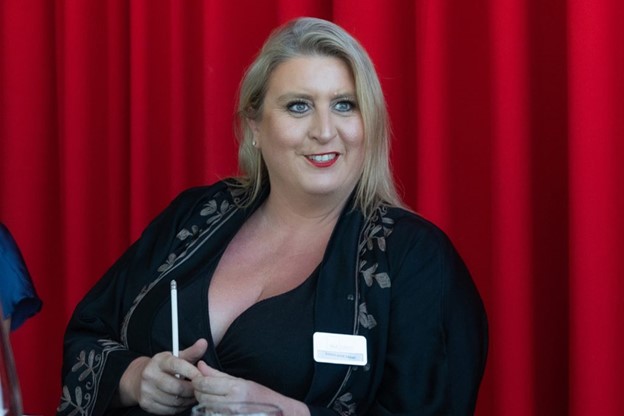
Grant added that the local market has much to offer and that upcycling is becoming more popular. “When a restaurant is refurbished, the materials are removed from that space,” she explained. “How can that be used for another project? How can that be upcycled? We’re seeing a lot of that too.”
Kassab, a designer from Woods Bagot, highlighted the importance of creating a strong narrative that guests can pick up on as soon as they walk into a space.
She explained: “You really want them to understand what you’re trying to tell them. You want them to get the hint of the story, to get the hint of the brand identity. And you need to make sure that all of the design elements within the space speak to that story.”
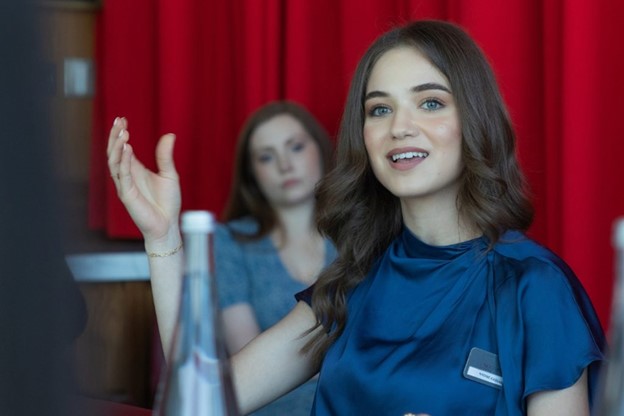
For 25hours Dubai One Central Hotel, she said FF&E was a crucial part of the design, not just a way of “filling the space”. Every piece was carefully chosen to contribute to the hotel’s
overall story, and guests could feel the connection between the furniture and the brand.
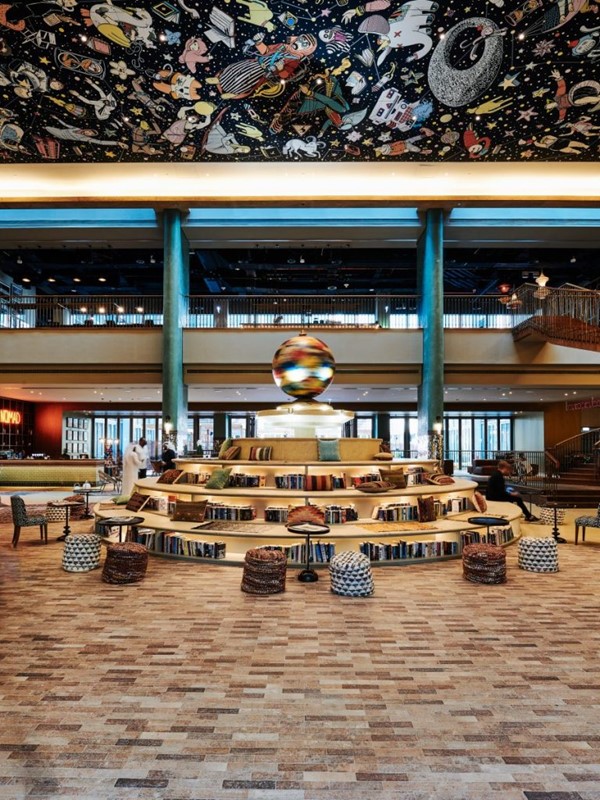
Kassab also highlighted the importance of locally sourcing accessories and artworks, working with local artists to ensure that all the pieces come together in a way that makes sense for Dubai and the brand.
“You want them to go and touch the pieces and then have a moment to realise that all of this is locally sourced and that layering of the space has meaning behind it, right? Whether it was just a cushion, whether it’s the curtains, the tassels on the chairs, they all complete the story,” she added.
James Prathap, general manager at NGC Nafees, reflected on the panel discussion. He said the role of FF&E in enhancing the user experience cannot be overstated.
“Throughout the discussion, it was evident that FF&E is not just about soft furnishings, but encompasses a wide range of materials and finishes that work together to create a cohesive and functional space,” Prathap explained.
The panelists also stressed the importance of understanding the functional requirements of a space and designing FF&E accordingly.
The final panel discussion took place at the SLS Dubai Hotel & Residences, a project that features some of the key products from NGC’s portfolio of wall coverings, fabrics and flooring.
This panel delves into how sustainability affects the hospitality industry, the impact of the global climate on design processes and clients’ decisions during the final stages of the FF&E (Furniture, Fixtures & Equipment) process, and the biggest barriers to building greener hospitality interiors.
The article highlights NGC Nafees, a sponsor of the Commercial Interior Design Awards, focusing on their expertise in walls, floors, and fabrics. NGC Nafees offers a wide range of high-quality materials that enhance interior spaces, blending functionality with aesthetic appeal. The company emphasizes sustainability, providing eco-friendly products that meet modern design needs. Their commitment to innovation and quality positions them as a key player in the interior design industry.
The panel discussion, titled – Rethinking office FF&E through refurbishment, reuse and recycle, features Lamya Maher from Broadway Interiors, Rita Estephan from Motif Interiors, Rocky Dela Fuente from KPS, Emanuel Marreiros from Summertown Interiors, Geetha Nayak from Design Infinity, Sunil Stanley from Inner Space Interior Design, and Najid Nazir from Spacewell Interiors.
The panel included Lara Francis el Hani from Kling Consult, Grammatiki Zamani of Kiklos Architects, Leali Ezzat from ELE Interiors, and Hannah Bower Brooks of Cherwell Interiors. The discussion was moderated by Marina Mrdjen from Intelier.
The panel included Dragana Cemalovic from Bluehaus Group, Vijay Nambiar from Roar, Adriana Graur from DWP, Stuart Allen from AAID, Joakim de Rham from Swiss Bureau, as well as NGC’s general manager James Prathap, as their host, and Marina Mrdjen from Intelier as the moderator.
Armstrong Flooring has over 150 years in building materials, offering various flooring types and recently launching D-10 coating for high-traffic areas, enhancing durability with synthetic diamonds. They focus on color and texture innovation for appealing interiors.
NGC Nafees started as a wallpaper retailer 30 years ago and now offers a broad range of surfaces, including walls, floors, and fabrics, catering to the growing demand for single-source suppliers in interior design, particularly in hospitality and government sectors.
28th July 2022
James Prathap is the general manager of NGC Nafees.
It wouldn’t be a Commercial Interior Design Awards without the support of our beloved sponsors.
Firms from the design industry are already pledging their valuable support to the 16th annual awards, which take place this year on 15 September 2022.
With the nominations coming in, we introduce our sponsor spokespeople for the 2022 awards – James Prathap, general manager of NGC Nafees.
Founded in 2006, NGC Nafees established itself as a leading provider of high-quality wall coverings, fabrics, and commercial flooring for residential and hospitality environments. From Missoni Home and Roberto Cavalli to York, Spradling and BLOQ, the company continues to offer the latest designs from leading European and American brands.
NGC Nafees is a category sponsor for the CID Awards 2022 and Prathap talks about what makes the company stand out from the rest…
Caustiously optimistic
With the iconic Marsa Al Arab hotel soon to be added to their project portfolio, Prathap shares NGC’s latest updates.
“It has been a great year for us, and we are very excited to announce that we have just been selected to supply the wall coverings for the guest rooms of Marsa Al Arab”.
An extraordinary take on the use of Custom Digital Wallpaper. Shown here are still-life shoots of high-end jewelry against our digital wallpapers. This is custom design made possible.
VOGUE ARABIA
Photography: Tina Patni
Style: Mohammad Hazem Rezq
Featured Product: Wallpaper
Collection: Magnolia Home
Brand: York
____________
Discover the Magnolia Home wallpaper collection by Joanna Gaines. “Wallcoverings have the ability to completely transform a room and make a unique statement. Whatever you choose, whether a bold or subtle pattern, I hope these designs personalize your space and help tell the story of your home.” – Joanna Gaines.
Find your true reflection and browse the Magnolia Home Wallpaper collection.
TELL US ABOUT YOUR COMPANY
With more than three decade of experience in the interiors industry, NGC Nafees claims to have established itself as one of the top interior design suppliers in the Middle East. The business, which has two showrooms in Dubai and one each in Sharjah and Mumbai, has partnered with more than 50 proven manufacturers to. supply the region with some of the finest interior design products. All of which can be applicable to any type of project required by the designer.
WHAT’S NEW
With the addition of flooring and fabric products to its portfolio earlier this year, NGC Nafees has complemented its existing range of wall coverings. It now offers a complete turnkey solution for interiors, giving its customers better choice and a wide range of services.
NGC Nafees was formed three decades ago to offer a comprehensive retail experience for people to buy wallpaper. As alternative markets developed, so did the business. With a rise in hospitality and government sector projects, the company added new product lines for all commercial applications. Over the years, the name has become a strong and established brand within the industry. Recently, the CID Awards 2019 sponsor took the opportunity to diversify its portfolio from wallpaper into walls, floors, and fabrics. This has enabled it to offer a wider range of interior design materials.
NEW ON THE MARKET
NGC Nafees has launched a wide range of products recently, not only in new product segments, such as flooring and fabrics, but to its burgeoning wallpaper collection. More clients are looking for a single materials supplier for interior design, and NGC Nafees says it wants to fulfill this by bolstering its portfolio of surface materials that it sells to architects and interior designers.
Featured Product: Fabrics
Collection: Calypso
Brand: Thibaut
____________
Bring the outdoors in with Calypso, a collection of coordinated Sunbrella indoor/outdoor woven fabrics. This collection is a natural extension of Thibaut’s offering in this category of performance. Sunbrella has been the most recognized and trusted name in performance fabrics for over 50 years.
The high-performance fabrics in this vibrant collection are lightfast and stain resistant, offering long-lasting beauty and durability. Pairing a satisfying hand with durability and performance, Thibaut’s Sunbrella collections are specifically engineered to be soft, luxurious fabrics that incorporate Thibaut signature style.
The Calypso collection features hip geometrics, luxurious textures, plush chenilles, matelasses and versatile sheers, providing countless combinations for a spirited and custom look. Patterns in the Calypso collection have been designed to coordinate with color families featured in the Portico collection.
Featured Product: Carpet Tiles
Collection: Fashion&
Brand: Modulyss
____________
Fashion& uses the power of colour upon a timeless base for a look that adds personality to any space. With its linear texture, subtle shine and 36 rich colourways, Fashion& brings a carpet tile for every style.
Working as the perfect tonal base to the beginning of a powerful layout, or as a free-form expression of colour in bold blocking, Fashion& lets you pick your own flooring style.
As part of the &-collection of carpet tiles designed to be mixed and matched, Fashion& brings tone-on-tone coordination or high-impact contrast with the rich drama of Velvet& and the perfectly imperfect pattern of Fluid&.

